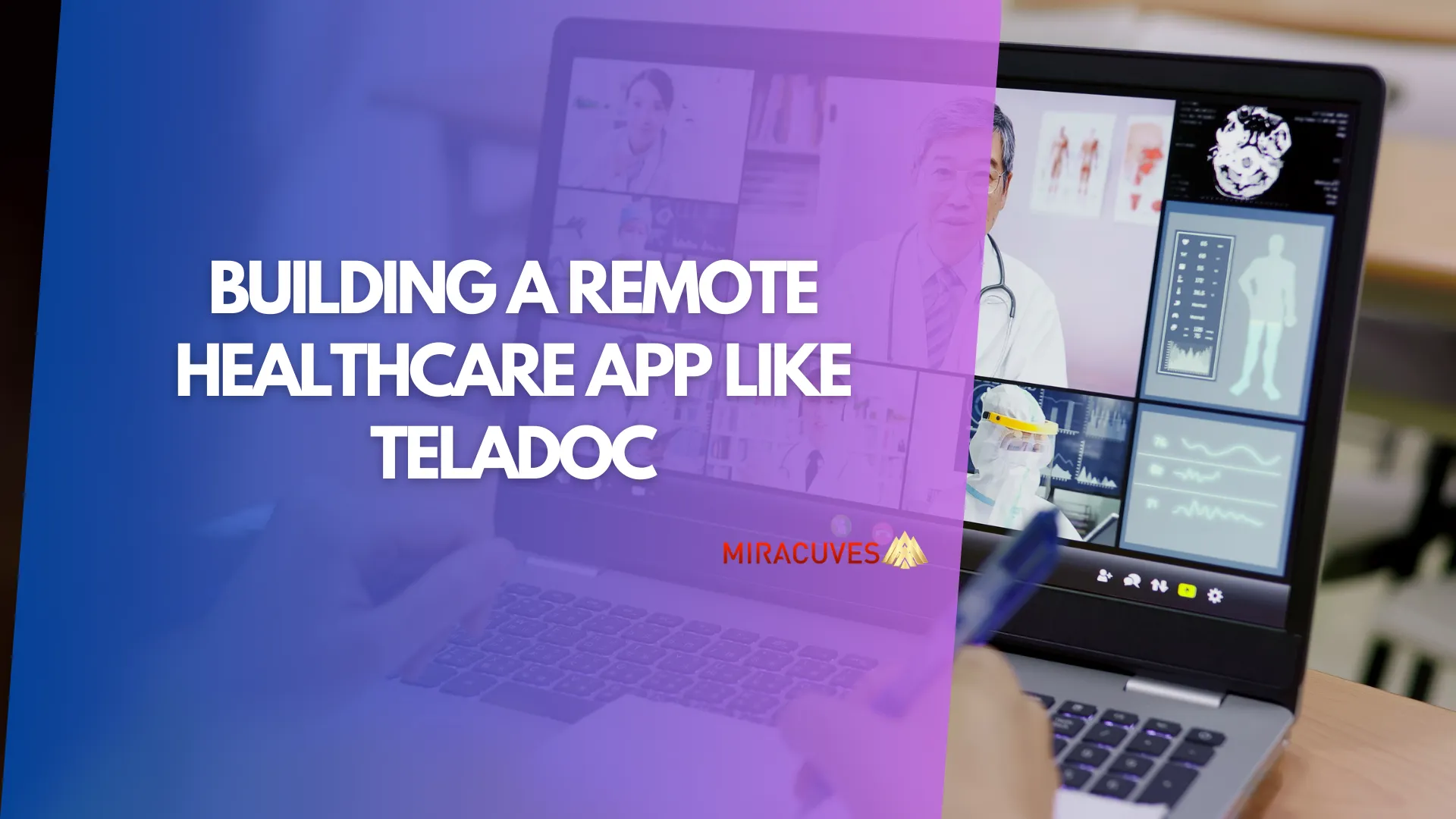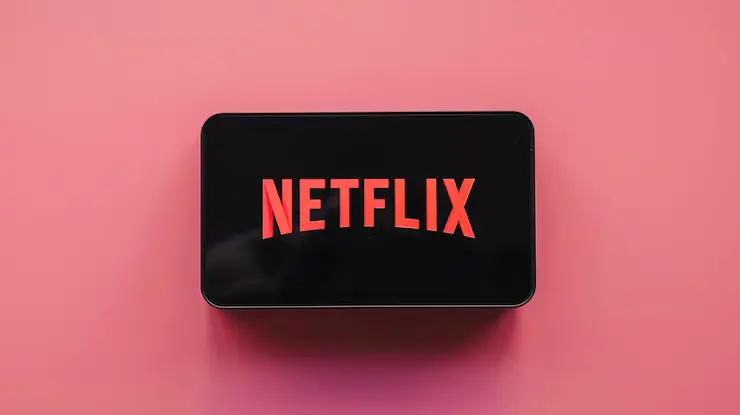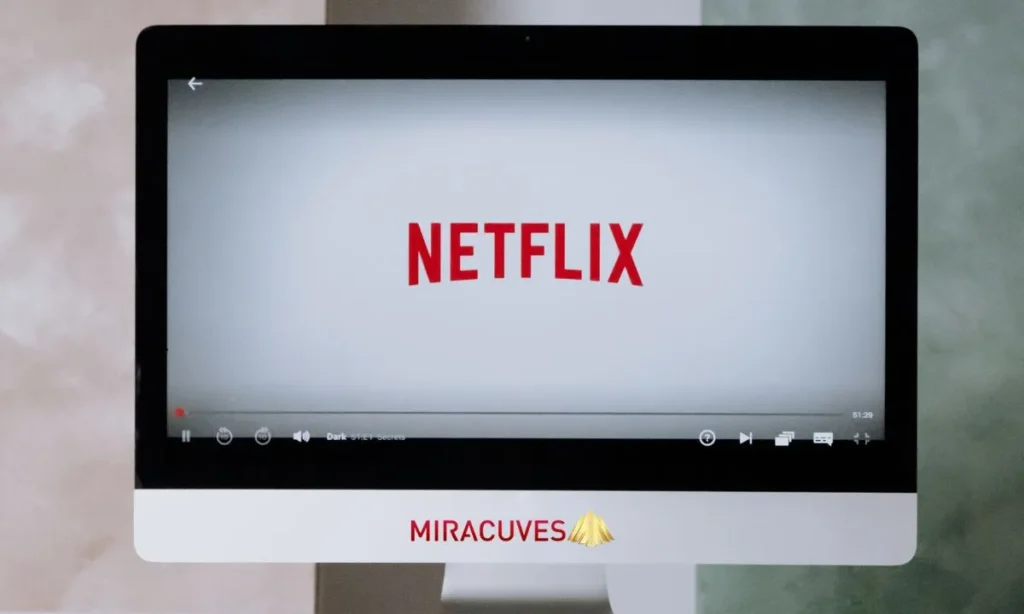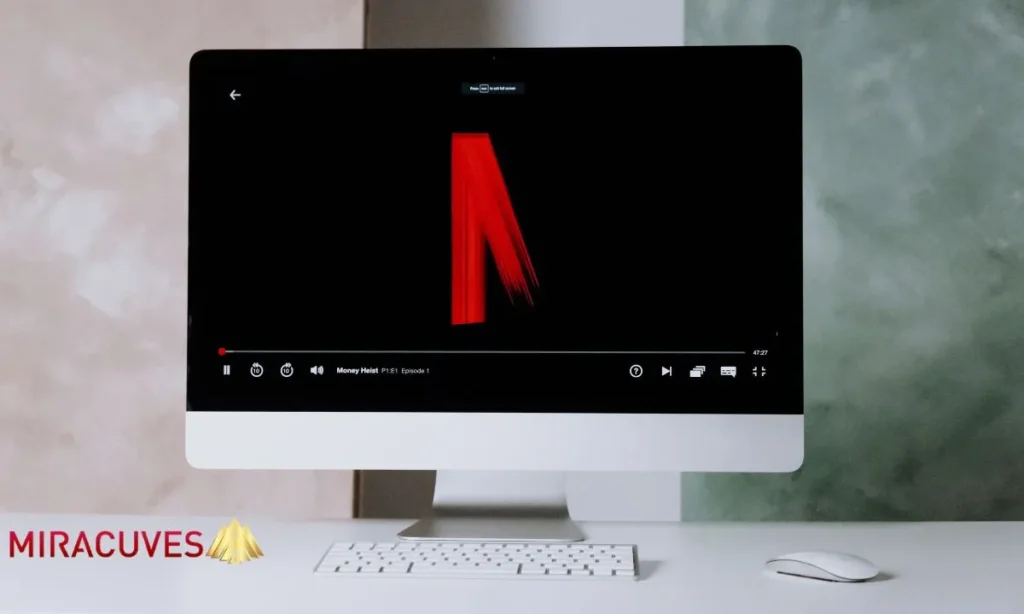The way we access healthcare has undergone a significant transformation, thanks to the rise of telemedicine platforms like Teladoc. In an increasingly digital world, remote healthcare apps offer patients the convenience of consulting with doctors from the comfort of their homes. These platforms bridge the gap between patients and healthcare professionals, making online consultations, prescriptions, and follow-ups accessible to all.
Developing a remote healthcare app like Teladoc is not just about replicating features. It’s about leveraging technology to provide fast, secure, and user-friendly solutions for both patients and providers. With the global telehealth market expected to grow by over 25% annually, building a similar platform offers enormous business opportunities.
If you’re wondering how to bring such a concept to life, this step-by-step guide will take you through the entire process—from essential features and technical requirements to cost estimation and market strategies. With Miracuves Solutions at your side, you can build your app at 10% of the global cost and in just 1 day instead of the industry-standard 1 month. Let’s dive into the key steps needed to create a remote healthcare app that can stand shoulder-to-shoulder with Teladoc.
What is Teladoc, and What Does It Do?
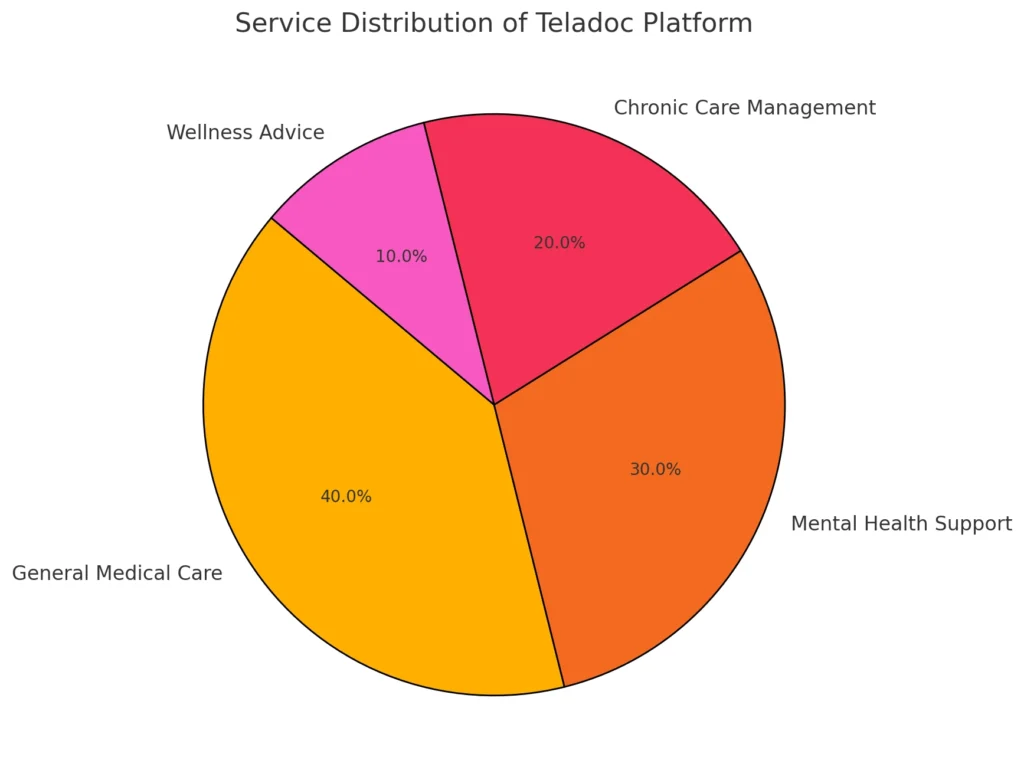
Teladoc is a leading telemedicine platform that connects patients with healthcare professionals through virtual consultations. The platform provides access to a wide range of services, including general medical care, mental health support, chronic care management, and wellness advice. With Teladoc, patients can consult doctors via video calls, phone calls, or chat sessions, ensuring seamless healthcare delivery anytime, anywhere.
One of the key aspects of Teladoc’s success is its convenience. Patients no longer need to visit clinics or hospitals physically. Instead, they can schedule appointments, receive e-prescriptions, and even get follow-up consultations online. This approach not only saves time but also reduces the pressure on healthcare facilities, making it a popular solution, especially in the wake of the COVID-19 pandemic.
Beyond individual consultations, Teladoc offers specialized services, such as mental health therapy and chronic condition management programs. By integrating advanced technologies like AI-powered health assessments and wearable device data, Teladoc ensures that both patients and providers benefit from data-driven, personalized care.
Building an app like Teladoc means understanding the seamless interaction between patients and doctors. It also involves adopting telemedicine best practices to offer high-quality care. With the right design and technology, a similar platform can help redefine healthcare delivery by making it accessible, affordable, and efficient for a broader audience.
Why Should You Build This App?
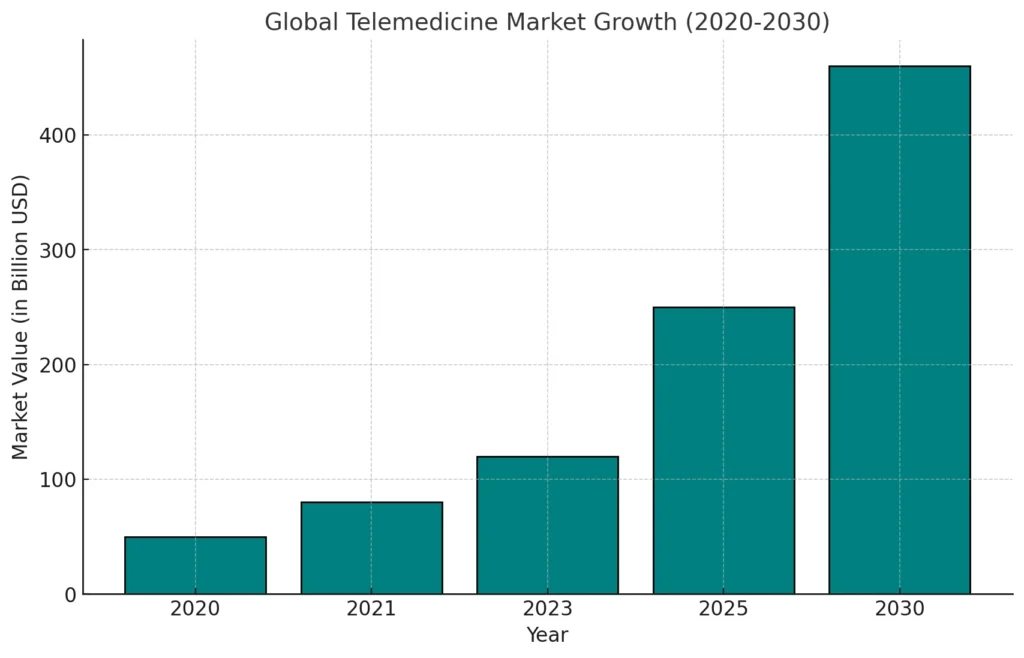
The demand for telemedicine and remote healthcare apps is growing at an unprecedented pace. With the rise of digital-first healthcare, apps like Teladoc have become essential, allowing patients to access care without leaving their homes. Building such an app is not just an opportunity—it’s a necessity in today’s healthcare landscape.
1. Increasing Demand for Telemedicine
Patients now prefer virtual consultations for convenience and safety. The COVID-19 pandemic accelerated the adoption of telehealth, and even as the world recovers, remote healthcare remains a preferred option for many. Chronic care management, mental health therapy, and general consultations are now just a click away.
2. Growing Market Opportunity
The global telemedicine market is projected to grow by more than 25% annually, with an estimated value of over $460 billion by 2030. Governments and private healthcare providers are also promoting telehealth solutions, which means building such an app can unlock significant business opportunities and partnerships.
3. Meeting Patients’ Expectations
People are more comfortable than ever with virtual interactions—whether it’s shopping, learning, or consulting with a doctor. A remote healthcare app provides on-demand service, bridging the gap between doctors and patients without geographical limitations.
By creating a feature-rich app, businesses can not only serve more patients but also build a profitable and scalable business model. With the right tools and infrastructure, your app can offer accessible healthcare to everyone, regardless of their location.
Also Read:- Build a Virtual Healthcare App Like MDLive
How to Differentiate Your App from Competitors
| Feature | Teladoc | Your App | Other Competitors |
|---|---|---|---|
| AI-Powered Symptom Checker | No | Yes | Partial |
| Wearable Device Integration | Partial | Full Integration | No |
| Multi-Language Support | No | Yes | Limited |
| Digital Health Profiles | Yes | Yes | Yes |
| Specialized Healthcare Services | General Services | Custom Niches (e.g., Mental Health) | General Services |
In a rapidly growing telemedicine market, standing out among competitors like Teladoc is essential. Differentiation is not just about adding features—it’s about solving user pain points more effectively. Here are key strategies to ensure your remote healthcare app offers a unique experience:
1. Integrate AI and Wearable Device Support
Using AI-powered symptom checkers or chatbots can help patients get quick assessments before their consultation. Additionally, integrating with wearable devices (like smartwatches) enables users to share real-time health data with doctors, enhancing remote monitoring and chronic care management.
2. Offer Multi-Language Support
Unlike many telemedicine apps, your platform can cater to a global audience by providing multi-language options. This ensures better accessibility and widens your target market.
3. Personalized User Experience
Allowing patients to select their preferred doctors or schedule recurring appointments builds user loyalty. Incorporate features like digital health profiles that store patient history, making every interaction smoother and more effective.
4. Build a Niche-Focused App
Instead of a one-size-fits-all platform, consider focusing on a specific healthcare segment, such as mental health services or pediatric care. Specialization allows you to develop deeper expertise and attract a dedicated audience.
These strategies not only help your app stand out from competitors but also position it as a valuable tool for patients and healthcare providers alike. With the right unique selling proposition (USP), you can carve out a niche and build lasting success in the telehealth industry.
Market Size, Growth, and Revenue Model
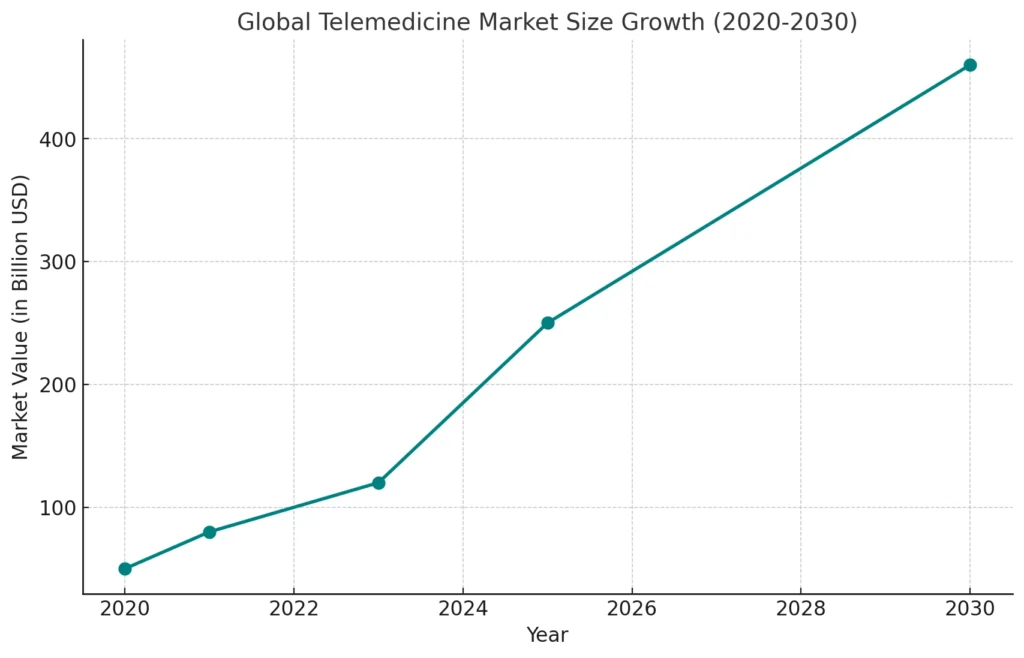
The telemedicine industry is on a rapid upward trajectory, driven by changing healthcare needs and digital adoption. The COVID-19 pandemic accelerated this growth, and even after recovery, the trend continues as people embrace the convenience of virtual care. Here’s a closer look at the market potential and revenue models that make building a telemedicine app a lucrative business.
1. Market Size and Growth Trends
- In 2020, the global telemedicine market was valued at $50 billion.
- By 2023, the market grew to over $120 billion and is projected to reach $460 billion by 2030.
- Key drivers include increased smartphone adoption, healthcare digitization, and the rising demand for chronic care and mental health services.
The market is also seeing growth due to government incentives, insurance companies supporting telehealth, and healthcare providers adopting digital platforms.
2. Revenue Models for a Telemedicine App
Developing a sustainable business model for your app is essential. Here are the most common ways telemedicine apps generate revenue:
- Subscription Plans: Users or healthcare providers pay a monthly or yearly fee for access to the platform.
- Pay-Per-Consultation: Patients are charged for each virtual consultation session.
- Insurance Partnerships: Collaborate with insurance companies to offer telemedicine services as part of healthcare plans.
- Advertising and Promotions: Pharmaceutical companies or health brands advertise within the app.
- Premium Services: Offer advanced features like priority appointments or detailed health analytics for an additional fee.
With these diverse revenue streams, you can build a scalable business model that grows along with your user base.
According to a report on telemedicine market growth, the industry is expected to reach $460 billion by 2030, driven by advancements in remote healthcare.
Features of the App
Creating a successful telemedicine app like Teladoc requires a combination of essential and advanced features. These features ensure smooth communication between doctors and patients while maintaining security, ease of use, and reliability. Below is a breakdown of the must-have features and additional functionalities that can make your app stand out.
1. Core Features for Patients and Doctors
- User Registration & Authentication: Easy sign-up options with secure login (via email, phone, or social accounts).
- Appointment Scheduling: Patients can book, reschedule, or cancel appointments in real-time.
- Video & Audio Consultations: High-quality video calls for remote consultations.
- E-Prescriptions: Doctors can send prescriptions digitally, ensuring faster treatment.
- In-App Chat Support: Patients can chat with doctors for follow-up or quick queries.
2. Administrative Features
- Admin Dashboard: Manage patient data, doctor profiles, and platform activities.
- Analytics & Reports: Real-time insights into app usage, revenue, and consultation stats.
- Payment Integration: Secure payment gateways for consultation fees or subscriptions.
3. Advanced Features for Enhanced User Experience
- AI-Powered Chatbots: Assist users with basic queries and symptom triaging.
- Wearable Device Integration: Sync with smartwatches and fitness trackers for real-time health monitoring.
- Multi-Language Support: Cater to diverse user groups by offering language options.
- Patient History & Health Records: Maintain digital health profiles for each user, accessible during consultations.
Also Read:- Top 10 Ideas for Healthcare Staffing Business Startups
Building a telemedicine app?
Let us guide you through the development process to create
a scalable platform that offers video consultations, secure
patient data storage, and in-app prescription services.
Technical Requirements
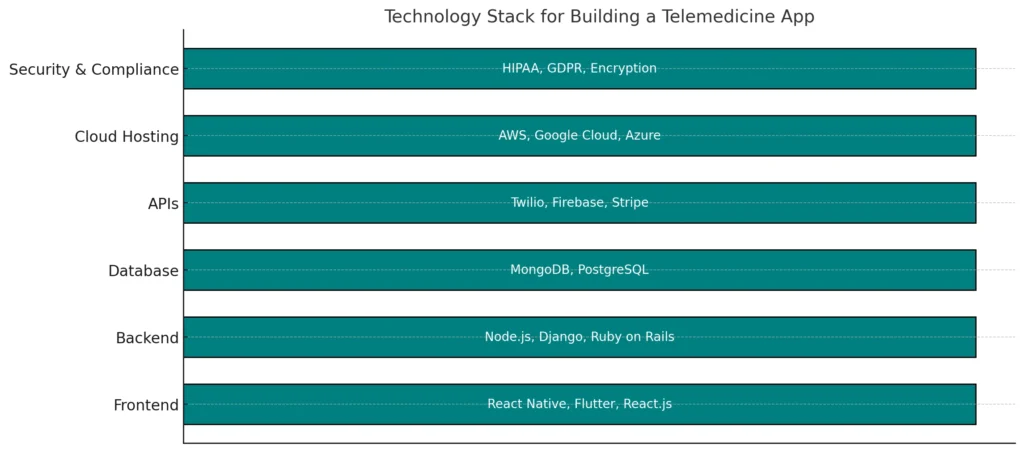
Building a telemedicine app like Teladoc requires a robust tech stack to ensure seamless functionality, secure communication, and smooth performance. Here’s a breakdown of the essential technical components needed to develop a reliable remote healthcare platform.
1. Frontend Development
The frontend is the user interface where patients and doctors interact. It needs to be intuitive and responsive across mobile devices and desktops.
- Technologies: React Native, Flutter (for mobile apps), React.js (for web apps).
- Key Considerations: Ensure smooth navigation, fast loading times, and accessibility across multiple devices.
2. Backend Development
The backend powers the app’s core functionalities, such as appointment scheduling, video calls, and e-prescriptions.
- Technologies: Node.js, Django, or Ruby on Rails for handling server-side logic.
- Database: Use secure databases like MongoDB or PostgreSQL to manage patient records.
- API Integrations: Twilio (for video calls), Firebase (for notifications), and Stripe (for payments).
3. Cloud Hosting and Data Storage
A telemedicine app requires reliable cloud hosting for uptime and scalability.
- Options: AWS, Google Cloud, or Microsoft Azure provide scalable cloud infrastructure.
- Data Storage: Ensure HIPAA compliance by using encrypted storage solutions for sensitive health data.
4. Security and Compliance
Telemedicine apps must comply with healthcare regulations to ensure patient data privacy and security.
- Regulations: HIPAA (USA), GDPR (Europe), and other local healthcare laws.
- Security Measures: End-to-end encryption for video calls and multi-factor authentication (MFA) for user login.
Design and User Interface
The design and user interface (UI) of your telemedicine app play a crucial role in ensuring user satisfaction and retention. A well-designed app should be simple, intuitive, and accessible to patients and doctors alike. Since healthcare can be complex, the goal is to reduce friction and make the entire experience as seamless as possible.
1. Intuitive and Accessible UI
- Simple Navigation: Users should be able to find doctors, book appointments, and access health records with minimal effort.
- Responsive Design: The app should function smoothly across smartphones, tablets, and desktops.
- Accessibility Features: Incorporate voice commands, larger text options, and color contrast settings to make the app user-friendly for all, including those with disabilities.
2. Engaging UX for Patients and Doctors
- Real-Time Notifications: Keep patients informed about upcoming appointments and prescription updates through in-app notifications.
- Doctor Availability Status: Allow doctors to set their availability so patients can easily book time slots.
- User-Centered Dashboards: Patients can track their consultation history and view prescriptions in one place, while doctors can manage appointments and patient records efficiently.
3. Visual Appeal and Branding
- Consistent Branding: Use calming color schemes (like blue and green) that align with healthcare themes.
- Minimalist Design: Avoid unnecessary elements to keep the focus on essential tasks such as booking appointments and chatting with doctors.
- Incorporate Icons and Graphics: Use easy-to-understand icons to enhance usability and reduce text clutter.
Development Process

Building a remote healthcare app like Teladoc requires a well-planned development process to ensure smooth execution and timely delivery. Following a structured workflow helps transform your idea from concept to launch, allowing you to start with an MVP (Minimum Viable Product) and scale the app over time.
1. MVP Development: Start Small, Scale Big
An MVP approach focuses on core features—such as appointment scheduling, video consultations, and e-prescriptions—ensuring the app is functional and user-ready at the earliest. This approach allows you to validate the product in the market and gather feedback for improvements.
2. Step-by-Step Workflow
- Idea Validation and Planning
- Identify the problem your app will solve.
- Research your target audience and competitors.
- Prototyping and Wireframing
- Create visual wireframes to outline the app’s design and flow.
- Ensure a seamless user journey with intuitive layouts.
- Frontend and Backend Development
- Use React Native or Flutter for frontend to ensure cross-platform compatibility.
- Build a secure backend with Node.js or Django to manage data and processes efficiently.
- API Integration and Testing
- Integrate APIs for video calls, notifications, and payments.
- Conduct thorough testing to fix bugs and ensure smooth performance.
- Launch and Deployment
- Launch the MVP and gather user feedback.
- Use insights from feedback to roll out new features in future updates.
3. Key Benefits of MVP Development
- Faster Time to Market: Launch your app with core features in weeks, not months.
- Lower Risk: Test the product with real users before committing to full-scale development.
- Budget-Friendly: Start with essential features, adding more over time as your budget allows.
Also Read:- How Practo’s Monetization Model Powers Online Healthcare Consultations
Cost Estimation and Timeframe
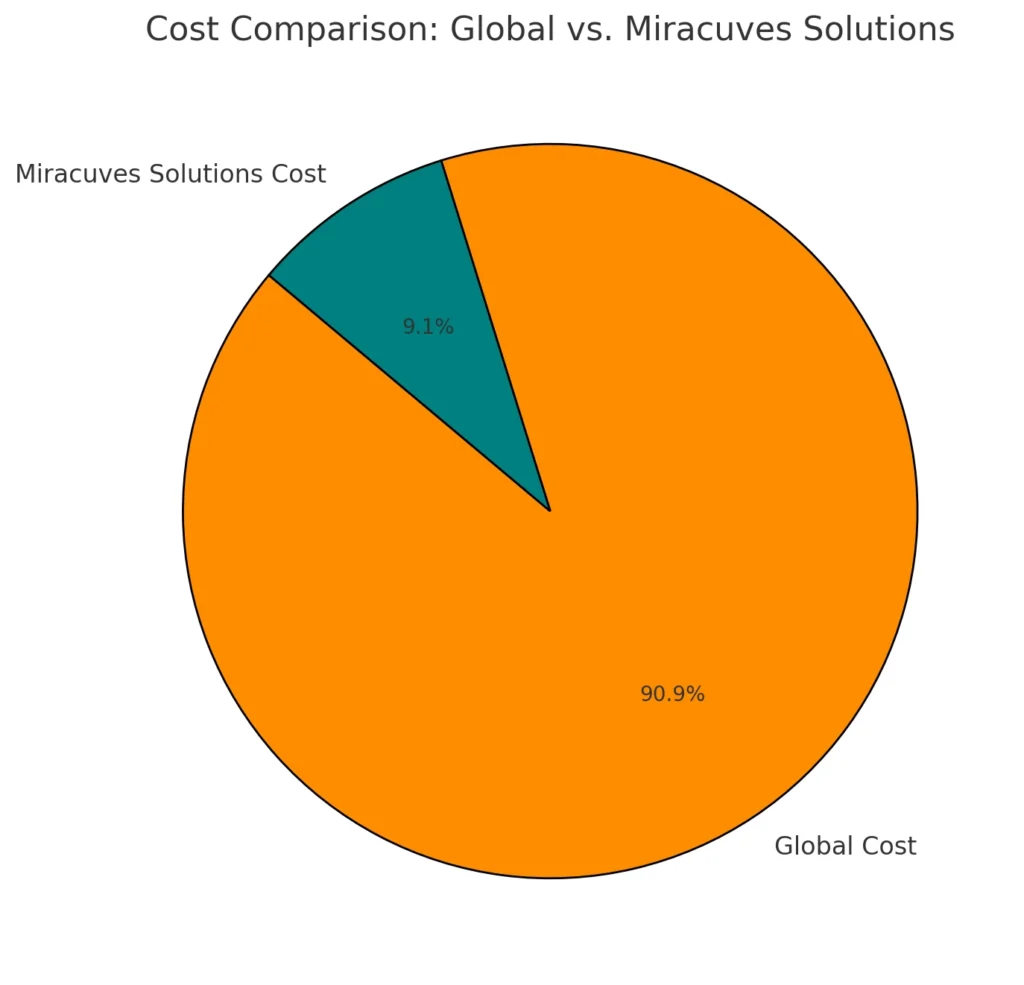
When building a telemedicine app like Teladoc, cost and time are critical factors. Understanding the global cost benchmark and how you can save time and money by leveraging optimized development models will help you plan better.
1. Global Cost vs. Optimized Cost
- Globally, developing a telemedicine app from scratch can cost anywhere between $6000 to $50,000, depending on complexity, features, and customization.
- With Miracuves Solutions, the cost is reduced to 10% of the global average—around $600, thanks to ready-mad solutions and efficient processes.
2. Timeframe Comparison
- Traditional development models can take up to 1-2 months to launch an MVP.
- Miracuves Solutions offers a rapid development model, delivering a fully functional MVP within just 1 day.
3. Cost Breakdown by Feature Development
Below is a typical breakdown of feature development costs in both global and optimized models.
| Feature | Global Cost ($) | Miracuves Solutions Cost ($) |
|---|---|---|
| User Registration & Login | 500 | 50 |
| Appointment Scheduling | 1000 | 100 |
| Video Consultation Setup | 2000 | 200 |
| E-Prescription Module | 1500 | 150 |
| In-App Chat Integration | 1000 | 100 |
| Admin Dashboard | 2000 | 200 |
Also Read :- Teladoc’s Monetization Model: How It Dominates the Telemedicine Market
Why Trust Miracuves Solutions for Your Next Project?
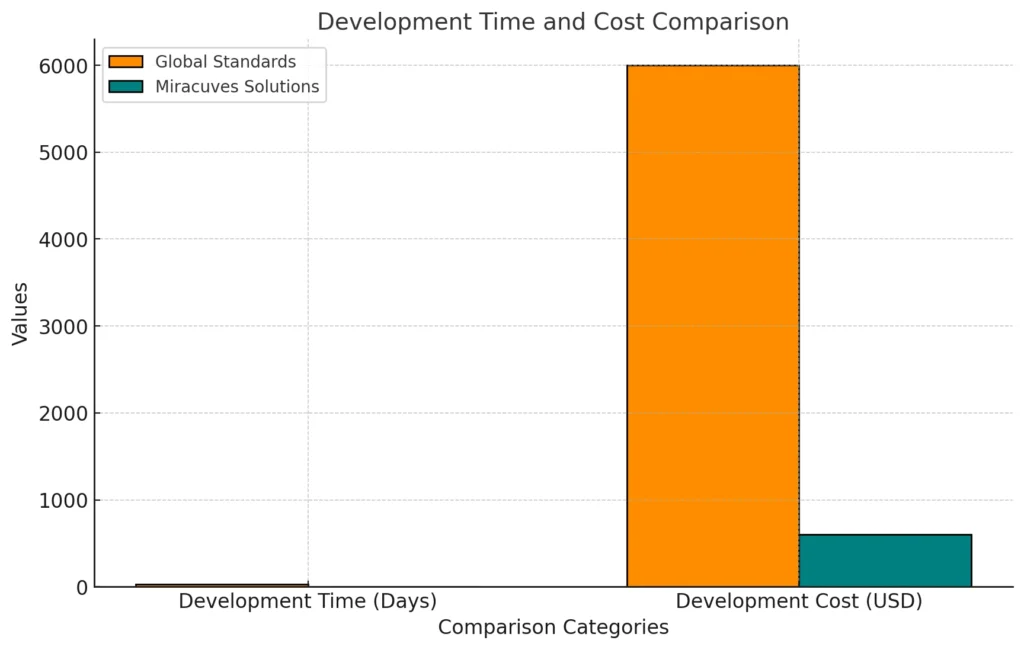
Choosing the right partner to build your telemedicine app is crucial for success. Miracuves Solutions stands out with its cost-effective, time-efficient, and scalable solutions designed to meet today’s healthcare demands. Here’s why Miracuves Solutions should be your top choice.
1. 10% of the Global Cost
Miracuves Solutions offers ready-made solutions and optimized development processes, reducing the cost to just 10% of the global average. For example, an app that typically costs $6000 globally will only cost $600 with Miracuves.
2. 30x Faster Development
Time is of the essence in today’s competitive market. While traditional development can take 1 month or more, Miracuves Solutions delivers a fully functional MVP within just 1 day—enabling you to launch faster and stay ahead of the competition.
3. Customizable and Scalable Solutions
Miracuves Solutions provides ready-made designs that can be easily customized to meet your specific needs. Whether you want to integrate AI features, wearable support, or expand into new markets, Miracuves helps you scale your app effortlessly.
4. Proven Expertise and Customer Satisfaction
With a track record of successful healthcare apps, Miracuves Solutions ensures that every project meets the highest quality standards. Customer testimonials and case studies demonstrate their ability to deliver fast, affordable, and reliable apps.
Monetization Strategies
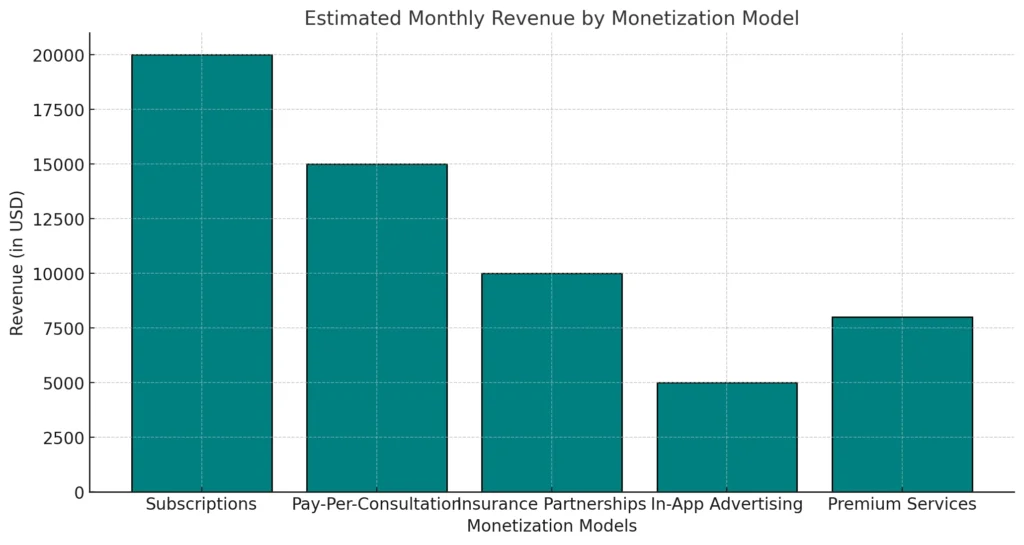
Creating a telemedicine app isn’t just about improving healthcare access—it’s also about building a sustainable business model. There are several revenue streams you can implement to ensure your app generates consistent income while adding value for users and healthcare providers.
1. Subscription Plans
Offer users monthly or yearly subscription packages for unlimited consultations or access to premium services. Healthcare providers can also subscribe to use the platform’s features.
2. Pay-Per-Consultation Model
Charge patients per consultation session, ensuring a steady stream of revenue. This model works well for users who prefer one-time services without committing to subscriptions.
3. Partnerships with Insurance Companies
Collaborate with insurance companies to offer telemedicine services under healthcare plans. This reduces patient costs and brings in additional revenue from insurance providers.
4. In-App Advertising and Sponsorships
Allow pharmaceutical companies and healthcare brands to advertise on your platform. This creates an additional revenue stream while offering targeted ads relevant to users.
5. Premium Services and Add-Ons
Introduce priority consultations, detailed health reports, or advanced AI tools as premium add-ons. Users can pay extra for faster appointments or personalized health analytics.
Launching and Marketing the App
Once your telemedicine app is ready, a successful launch and strategic marketing plan are essential to attract users and establish your brand. Launching involves more than just uploading your app to stores—it requires careful planning and a well-executed marketing strategy to create awareness and encourage downloads.
1. Pre-Launch Strategies
- SEO and ASO Optimization: Ensure your app is optimized with relevant keywords to rank higher in app stores and search engines.
- Beta Testing: Conduct beta testing with a small group of users to identify bugs and gather feedback for improvements.
- Pre-Launch Campaigns: Use email marketing and social media teasers to build anticipation and excitement for the launch.
2. Post-Launch Strategies
- Influencer and Social Media Marketing: Collaborate with influencers and healthcare professionals to promote your app.
- Referral Programs: Encourage users to invite others by offering incentives like discounts or free consultations.
- Push Notifications: Engage users with reminders about appointments or offers to keep them active on the platform.
3. Tracking Performance and Making Improvements
- Use analytics tools to track downloads, user behavior, and engagement.
- Monitor user reviews and quickly address any complaints or suggestions.
- Plan for regular updates to introduce new features and enhance the user experience.
Legal and Regulatory Considerations
When developing a telemedicine app, compliance with legal and regulatory frameworks is essential to ensure the safety and privacy of users. Since healthcare involves sensitive personal data, strict laws govern data handling and online consultations. Ignoring these rules can lead to severe penalties and loss of trust among users.
1. Data Privacy and Security Compliance
- HIPAA (Health Insurance Portability and Accountability Act): Required for healthcare apps operating in the United States to protect patient data privacy.
- GDPR (General Data Protection Regulation): Governs the collection and use of personal data in Europe. It requires explicit user consent and safeguards to prevent data breaches.
- Local Regulations: Apps must also adhere to regional healthcare laws specific to each country or state.
2. Licensing and Certification Requirements
- Healthcare Provider Licenses: Ensure that all doctors and healthcare professionals using your platform are licensed and accredited.
- Telemedicine Permits: In some countries, permits are required to offer remote healthcare services.
- Prescription Laws: Your app must comply with online prescription regulations, which vary across regions, especially for controlled medications.
3. Liability and Insurance Considerations
- Liability Insurance: Protects your business from legal claims related to malpractice or service failures.
- Terms of Use and Privacy Policy: Your app must clearly outline terms and conditions to limit liability and explain how user data will be used.
Telemedicine apps operating in the United States must comply with HIPAA regulations to ensure patient data privacy and security.
Future Growth and Trends
The future of telemedicine holds immense potential, driven by advancements in technology, evolving healthcare needs, and consumer expectations. As the industry grows, staying updated with emerging trends and innovations will be key to maintaining a competitive edge.
1. Integration of Artificial Intelligence (AI)
- AI-powered chatbots will become more common, helping with initial consultations, symptom analysis, and patient queries.
- Predictive analytics will assist doctors by analyzing patient data to recommend personalized treatments and detect early warning signs.
2. Wearable Technology and Remote Monitoring
- The use of wearable devices—such as smartwatches and fitness trackers—will allow continuous health monitoring.
- This trend is especially relevant for managing chronic conditions and ensuring proactive care through real-time data sharing.
3. Expansion of Virtual Reality (VR) and Augmented Reality (AR)
- VR and AR tools will revolutionize mental health therapy, physical rehabilitation, and training for healthcare professionals.
- These technologies will provide immersive therapy sessions and improve remote medical education.
4. Globalization and Cross-Border Healthcare
- Telemedicine apps will transcend national borders, offering consultations with doctors worldwide, powered by multi-language support and international compliance frameworks.
- Medical tourism is expected to grow as patients use remote consultations to plan treatments abroad.
| Trend | Impact on Telemedicine |
|---|---|
| AI-Powered Chatbots and Predictive Analytics | Improves efficiency by automating consultations and offering personalized treatment recommendations. |
| Wearable Technology and Remote Monitoring | Enables continuous health tracking and proactive care, especially for chronic diseases. |
| Virtual Reality (VR) and Augmented Reality (AR) | Revolutionizes therapy and training with immersive experiences for patients and professionals. |
| Globalization and Cross-Border Healthcare | Expands access to healthcare services globally, promoting medical tourism and international collaboration. |
Conclusion
Building a telemedicine app like Teladoc is more than just a business opportunity—it’s a way to reshape healthcare for the digital age. As remote healthcare becomes the new normal, offering patients quick, easy access to medical professionals can create meaningful change in their lives. The rising demand for virtual healthcare services, coupled with advancements in AI, wearables, and global connectivity, makes this the ideal time to invest in a telemedicine platform.
By focusing on core features, legal compliance, and a scalable business model, you can create a platform that competes with the best while also offering unique solutions to stand out in the market. Choosing Miracuves Solutions for your project ensures that you save time and cost with ready-made solutions and custom features, allowing you to launch within a day at 10% of the global cost.
Are you ready to transform healthcare and bring your idea to life? With the right strategy and support, your telemedicine app can become the next game-changer in healthcare.
Build a telehealth service like Teladoc?
Teladoc with features like virtual doctor visits, prescription management, and real-time patient tracking.
FAQs
How long does it take to build a telemedicine app?
With traditional development methods, it may take 1-2 months. However, Miracuves Solutions can deliver a fully functional MVP in just 1 day.
Can I customize the app to fit my business model?
Absolutely! Miracuves Solutions offers ready-made solutions that are fully customizable to meet your specific needs and preferences.
Is the app compliant with healthcare regulations like HIPAA?
Yes, the platform will be HIPAA and GDPR compliant, ensuring the security and privacy of patient data across different regions.
How can I monetize a telemedicine app?
You can generate revenue through subscriptions, pay-per-consultation models, insurance partnerships, and in-app advertising.
What makes Miracuves Solutions a good choice for app development?
Miracuves Solutions offers 10% of the global cost with 30x faster delivery, providing a combination of speed, affordability, and customization options.



